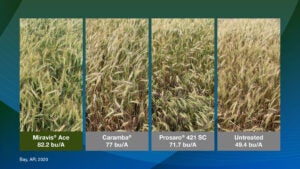This fungicide’s advanced ADEPIDYN technology capitalizes on premium plant-health benefits to help optimize yields.
Gone are the days when simply stamping out disease is a sufficient goal for a wheat fungicide. Modern chemistries that control some of the most devastating pathogens, such as Fusarium head blight, also bring a suite of plant-health benefits that improve yield potential even in the absence of high disease pressure.
For years, manufacturers leaned on triazole as the flagship component of wheat fungicides that fight Fusarium head blight, a disease also known as head scab that has cost American wheat farmers billions in recent years. In fact, the disease crisis grew so severe that the use of triazole fungicides in the U.S. increased fourfold between 2006 and 2016.
Then just two years afterward, a new mixture arrived to deliver a more comprehensive approach to battle wheat disease while helping increase plant health and dynamically improving yield potential.
Syngenta’s Miravis® Ace fungicide, which uses ADEPIDYN® technology mixed with propiconazole, became the first commercially available solution for head scab that’s not fully dependent on triazole chemistry.
The ADEPIDYN technology is a broad-spectrum fungicide that belongs to a new chemical group considered to be a next-generation approach, due to its unique molecular structure and related properties. It brings a forward-facing mode of action in this space: the high-performing carboxamide succinate dehydrogenase inhibitor (SDHI) — a unique segment within the Group 7 fungicide chemistry that acts against Fusarium in ways that other SDHIs can’t.

While it protects against several diseases in cereal crops, it has also become a cornerstone for plant-health benefits. Not only does the ADEPIDYN technology in Miravis Ace lower the leaf transpiration rate in plants to make them more tolerant of drought, but it does so without negatively affecting the photosynthetic properties of the plant.
This makes the application of Miravis Ace important even when it’s unclear what kind of disease conditions will be in place. Trial data has consistently shown that using Miravis Ace leads to an 11.6 bu/A1 yield increase over untreated wheat, and Tyler Harp, Syngenta Technical Product Lead for Row Crop Fungicides, said that it often amounts to a five to six bu/A increase over competing fungicidal products2.
“You don’t always know what the conditions are that will cause that really severe disease situation,” Harp said. “But when you use a plant-health product like Miravis Ace that contains ADEPIDYN technology, you’re more than likely to get a yield benefit either way — not only because the disease control is strong, but also because of the plant health.”
Syngenta has done studies in controlled growing spaces where ADEPIDYN technology proves to nurture more green leaf area than competitor products, allowing for more efficient use of light energy, water, and nutrients in crops.
The yield bump “doesn’t always correlate to a dry or wet year, or to a heavy disease year,” said Harp, who has worked for Syngenta since 1999. “We see good yield benefits, even under low disease years when it was dry, because of the potential for ADEPIDYN technology to increase the efficiency of the plant.”
In wheat specifically, Harp noted that intensive testing was done by a contract research organization in Kentucky. He said that the feedback he was given from that firm boiled down to: “Every treatment that contained ADEPIDYN was better than every treatment that didn’t contain ADEPIDYN.”
Growers have repeatedly signaled their appreciation for Miravis Ace’s rainfastness — binding quickly and strongly to the plant’s wax layer before slowly penetrating into the plant tissue. This ensures that there is less run-off and no need for further “catch-up” sprays after rain.
“This year’s fungicide performance was phenomenal. The disease pressure in wheat was controlled fantastically by Miravis Ace — so well, in fact, that we saw wheat yields far above normal averages,” said Willard Morris, a grower from Watertown, Wisconsin.

In many environmental circumstances, the Fusarium mold produces a mycotoxin called deoxynivalenol (DON), otherwise known as vomitoxin. Containing a carboxamide SDHI, Miravis Ace better reduces the level of mycotoxin contamination in wheat, which significantly contributes to improved safety for food and feed.
And while the combination of disease-prevention and curative properties of Miravis Ace offers more application flexibility than growers would see from other products, Syngenta still recommends that growers try to hit the same flowering timing that triazoles are currently positioned for. According to Harp, data shows that optimal plant health and the best yields are connected to significant DON reduction and efficacy.
“Miravis Ace on my wheat has been the best fungicide I’ve found. Not only does it increase yield and test weight, it also keeps the straw cleaner and brighter,” said Bradley Richardson, a grower from Tennessee.
Syngenta’s ADEPIDYN technology is also particularly valuable from a health and environmental standpoint, carrying an excellent crop safety profile. This is true whether used on its own, in pre-mixes, or in tank-mixes. It can replace less environmentally friendly compounds, especially ones that are being removed from the market for regulatory reasons or ones that are becoming less effective due to disease resistance.
“Miravis Ace worked well,” said Loren Bock of Belfield, North Dakota. “We had ideal conditions for head scab, and the fungicide did its job. We had the best wheat yields we have ever seen.”
This article was published on behalf of Syngenta. Visit this page to find a Syngenta Crop Protection Specialist near you.
Ryan Tipps is the founder and managing editor of AGDAILY. He has covered farming since 2011, and his writing has been honored by state- and national-level agricultural organizations.



